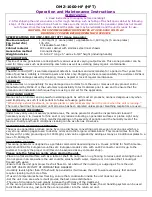
109
Electrical System Installation
Due to our policy of continuous product innovation, some specifications may change without notification.
©LG Electronics U.S.A., Inc., Englewood Cliffs, NJ. All rights reserved. “LG” is a registered trademark of LG Corp.
ELECTRICAL
Communication Cable Specifications
From Indoor Units to Remote Controllers
• Communication cable from Indoor Unit to Remote Controller(s) is to be 22 AWG, 3-conductor, twisted, stranded, unshielded. Wiring must
comply with all applicable local and national codes.
• If the length needs to be extended, the LG Extension Kit (sold separately) must be used. A maximum of four (4) kits (up to 165 feet) can be
used.
• Remote Controllers have hardwired connections: SIG - 12V - GND (Comm.) terminals.
• Indoor unit controller connections depend on type of indoor unit being installed. Some indoor units use terminal block connections; other
indoor units use Molex connections. See diagrams below for the two options. Refer to the wiring diagram schematic found in the indoor unit
itself, or to the indoor unit wiring diagrams in the Engineering Manuals for more information.
•
NEVER splice, cut, or extend cable length with field provided cable. Always include enough cable to cover distance between the indoor
unit and the remote controller.
• Set the indoor unit operating parameters using DIP switches, or by setting up the remote controller. Refer to the indoor unit installation
manuals for more details.
From Master Outdoor Unit to Central Controllers
• Communication cable from Master Outdoor Unit to Central Controller is to be 18 AWG, 2-conductor, twisted, stranded, shielded. Ensure the
communication cable shield is properly grounded to the Master ODU chassis only.
Do not ground the communication cable at any other
point. Wiring must comply with all applicable local and national codes.
• Connect all central control devices on the same cable if cable requirements are the same.
• Order does not matter, but polarity does. Keep “A” terminals with “A” terminals, and “B” terminals with “B” terminals. Starting at the outdoor
unit, terminate the cable on terminals Internet A and Internet B.
• Route the cable as needed between each device.
• Tie shields together at each termination point.
• Add insulation material as recommended by local code.
Cable requirements may differ depending on other installed components:
• Communication cable from Master Outdoor Unit to Mode Selector Switch is to be 18 AWG, 3-conductor, twisted or non-twisted, stranded,
shielded. Ensure the communication cable shield is properly grounded to the Master ODU chassis only.
Do not ground the communica-
tion cable at any other point. Wiring must comply with all applicable local and national codes.
Cable connected to Zone Controller is the factory default connection.
One Example of Indoor Unit to Zone Controller Connection.
BACnet-
BACnet Common
Not used
Not used
Not used
Common
4 5 6
13 14 15
Typical Indoor Unit
Signal
12VDC
YL
RD
BK
CN-REMO
Indoor Unit
R D
B K
Y L
Front
CN-REMO
R D B K
Y L
Back
Another Example of Indoor Unit to Zone Controller
Connection.
















































